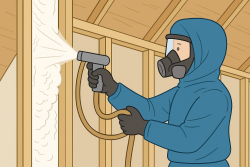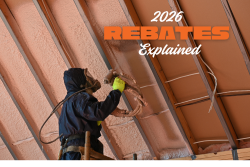As a contractor or builder working in Waterloo, Ontario, it is vital to be informed about mitigating radon buildup in residential and commercial properties. Radon, a naturally occurring radioactive gas, poses a significant health risk, particularly in areas like Waterloo, where the underlying rock and soil composition can vary. Understanding and implementing effective radon mitigation strategies is a matter of compliance and a commitment to public health and safety.
Radon Presence in Waterloo, Ontario
In Waterloo, just as in other parts of Canada, homes and buildings are susceptible to radon gas infiltration. Radon is odourless, tasteless, and colourless, making it undetectable without proper testing. It can seep into buildings through cracks in foundations, construction joints, and around service pipes. Radon exposure is a serious health concern, being the leading cause of lung cancer in non-smokers in Canada. Unfortunately, despite this risk, many homeowners in Waterloo are unaware of radon's presence and the need for testing and mitigation.
The Role of Reitzel Insulation in Radon Mitigation
Builders and contractors in Waterloo can turn to Reitzel Insulation for effective solutions for radon mitigation. Their expertise in insulation methods is crucial in creating barriers against radon infiltration. Specifically, spray foam insulation in construction and retrofitting projects is a proactive approach to radon mitigation.
Incorporating Spray Foam Insulation for Radon Barrier
Spray foam insulation, particularly closed-cell spray foam (ccSPF), offers a robust solution for sealing cracks and joints where radon can enter a building. The seamless nature of ccSPF creates an uninterrupted barrier, significantly reducing the chances of radon infiltration. This approach is practical not only in new construction but also in retrofitting existing buildings in Waterloo.
Applying ccSPF in areas such as basements, where radon levels are typically higher, provides both insulation and a radon barrier. By sealing off potential entry points, ccSPF dramatically diminishes the risk of radon accumulation inside living and working spaces.
Ensuring Professional Application
It is essential to ensure that certified professionals apply spray foam insulation, particularly for radon mitigation. In Waterloo, Reitzel Insulation stands out as a reliable service provider. Their team of experts ensures that the insulation is used correctly and effectively, making buildings in Waterloo safer and more energy-efficient.
Understanding Radon Testing and Mitigation Approaches
Radon testing is the first step in understanding the extent of radon presence in a building. In Waterloo, it is advisable for homeowners and builders to conduct radon tests after construction and at regular intervals to ensure safety. If high radon levels are detected, implementing mitigation systems becomes crucial.
There are two primary approaches to radon mitigation: passive and active systems. Passive systems involve using pipes and stack risers to naturally vent radon out of the building. On the other hand, dynamic systems use mechanical fans to enhance the venting process. Both methods require a thorough understanding of the building's structure and its specific radon challenges.
Conclusion
Radon mitigation is critical to building construction and maintenance in Waterloo, Ontario. As builders and contractors, understanding the various radon testing and mitigation methods and incorporating effective solutions like closed-cell spray foam insulation is imperative. Companies like Reitzel Insulation play a pivotal role in providing these solutions, ensuring that homes and buildings in Waterloo are safe from the health hazards posed by radon gas. By staying informed and utilizing the right materials and techniques, builders and contractors can significantly contribute to the health and well-being of the Waterloo community.

















